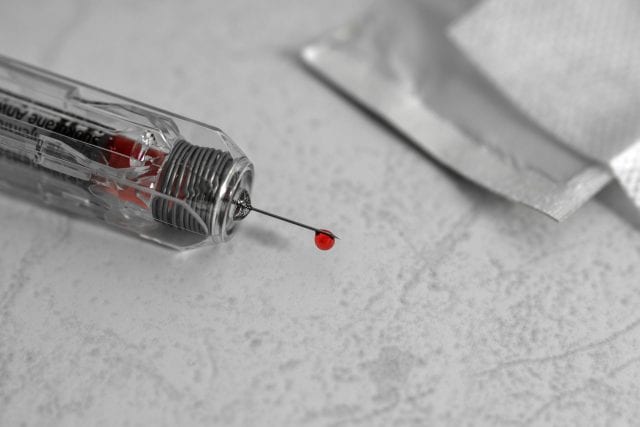
Hematophobia: Can you overcome the fear of blood? The answer might surprise you.
Hematophobia. Can you overcome the fear of blood? There are many people who suffer from blood phobia. An illogical and irrational fear takes hold of them when they see (and even think) of a wound, needles, cuts, syringes, hospitals, etc. Anything related to blood scares them. Find out what hematophobia is and how to overcome it:
Few of us like to see blood. It is normal to feel rejection, even experience unpleasant feelings (dizziness, nausea, and even fainting). The problem comes when the anticipation of these sensations produces such intense fear that it leads us to avoid any situation that has to do with blood. They even prevent the person to undergo hospital intervention or medical care.
The only way to overcome the fear of blood is by exposing ourselves and getting used to it. The challenge lies in the first approximations, where dizziness and discomfort are the usual response. For all those who wish to try it, in this post we explain what is hematophobia, and how to deal with it.
Sometimes when people are exposed to situations that involve blood the body secretes adrenaline into the blood stream. This boost of active chemicals helps the body do things that it is usually incapable of. The body is more prepared to deal with these type of situations when being exposed to blood and you may be surprised how much you can tolerate it while in the act of saving someones life or helping an injured animal out of harms way. Blood is natural and being afraid of it is very common, see what you can do to adapt to the trauma associated with being exposed to blood.
Homophobia: Fear of blood
It’s a hot summer day. The temperature under the sun is scorching, but we are sitting comfortably in a chair on the terrace of our house. Under a shade that casts a pleasant shadow, we share the table with some good friends after a hearty meal. However, this idyllic image will soon give way to a terrifying and typically “Tarantinian” episode.
Someone decides that the best way to be less full from the meal is by eating a piece of watermelon. The person in charge of cutting the watermelon has very little fine motor skills. This story ends with him screaming because he has cut himself. A bruised finger is clamped with a cut that is astounded by its small size and incredible bloodstream. As our friend bleeds, we begin to feel a sensation of discomfort, dizziness, we move to a chair, we don’t want to look, we lose strength in our hands. At that moment a cry for help comes out of our throat with incredible force:”Someone call an ambulance… I’m going to faint!
This is more common than it seems. Many people, from first-year medical students to gore viewers, have suffered the symptoms of what professionals call Hematophobia.
Blood phobia: Hematophobia
Fear of blood can be called Hematophobia: People who suffer from it fear wounds, hospitals, cuts, and syringes. This phobia can sometimes have troublesome consequences for the person and can lead to more serious disorders such as anxiety and incapacity to undergo medical care (such as a simple blood test) or the ability to provide help to a person who has had an accident.
In addition to being rare, these cases are usually the most problematic, in the sense that this fear prevents them from leading a normal or healthy life. Hematophobia is characterized by the anticipation of thoughts (“I’m sure that if I go to the doctor I’ll have to have surgery”) and avoidance (“I’d better not go, I rather not know”).
The important thing and the most interesting thing is that just by observing needles, blood, viscera or wounds, produces in some people a concrete physiological reaction. The good news is that this reaction can become controllable and can be overcome.
Hematophobia: A biphasic response
People, who are afraid of blood experience a biphasic response, what does this mean? that our organism, when it sees (or thinks) about any issue related to blood, responds in two stages:
In the first phase, and as a result of the shock and fright typical anxiety response is given. Our physiological aspects, for example, heart rate, blood pressure, and breathing rate decide to rate skyrocket.
The second phase, which follows, is the subsequent hangover that makes these same variables that had been triggered, decrease abruptly. Hence, blood does not circulate to the periphery and we have that feeling of lack of strength in our hands. The blood supply is also reduced, and the end result can be fainting.
In fact, the fainting rate, according to some authors, is as high as 80%. Considering that the prevalence is about 40% of the population. Well, statistically, a lot of people faint with blood.
Hematophobia: Overcome your fear
If everyone were to suffer from this phobia, who would be in charge of performing surgery? Although it is largely a natural response, there are people who while being exposed to blood, manage to overcome the fear without even knowing it. There are people who avoid any situation that exposes them to these situations (hospitals, injured people, blood tests or donations). It is at this point that hematophobia can appear as a psychological disorder. But to reach the point of disturbance, it must clearly affect our normal life, and especially our health.
The good thing about all this (yes, there can be something good!) is that there are ways to deal with that fear.
We can practice relaxation at home and apply it the next time we feel that the fear of blood and its biphasic response take hold of us.
These tips are intended for those who want to try a useful way to learn how to respond to these situations, but the ideal would be to go to a psychologist if the symptoms are intense.
1- Sit down
The feeling of dizziness may result in fainting. If we are sensitive to blood pressure, it is important that you always sit down to avoid hurting yourself.
2- Squeeze Strongly- Arms
Put your hands on your legs. Squeeze your fists like you have something in your hands, hold on for 10-15 seconds and then let go.
3- Breath slowly and relax
Reduces stress by controlling your breathing. Relax your hand muscles, this part will last approximately 15-20 seconds.
4- Squeeze Strongly- Legs
Force the soles of your feet against the ground while squeezing your knees together. Same time as in the case of the arms.
5-Breath slowly and relax
Loosen your legs and stay that way for 15-20 seconds.
6- Squeeze Strongly- Body
In this part, we will tighten the body like if we were going to stand up position. We will lift the buttocks off the chair and clench your whole body. This position is the one we adopt when we are several people at home and the bell rings. We make the gesture of getting up while we say “I’m coming,” but in reality, we’re not really making the effort to get up. This position will clench your whole body.
7-Breath slowly and relax
Same as the other two cases of relaxation.
8- Maximum voltage and End
Once you have contracted all the muscles you can now be conscious that you have relaxed the whole body.
The above technique is used in therapy to treat this type of phobias. Remember to always be aware of your fears and brain train your cognitive abilities. CogniFit offers different platforms were you can evaluate and train different aspects of cognitive skills and mental health disorders.















